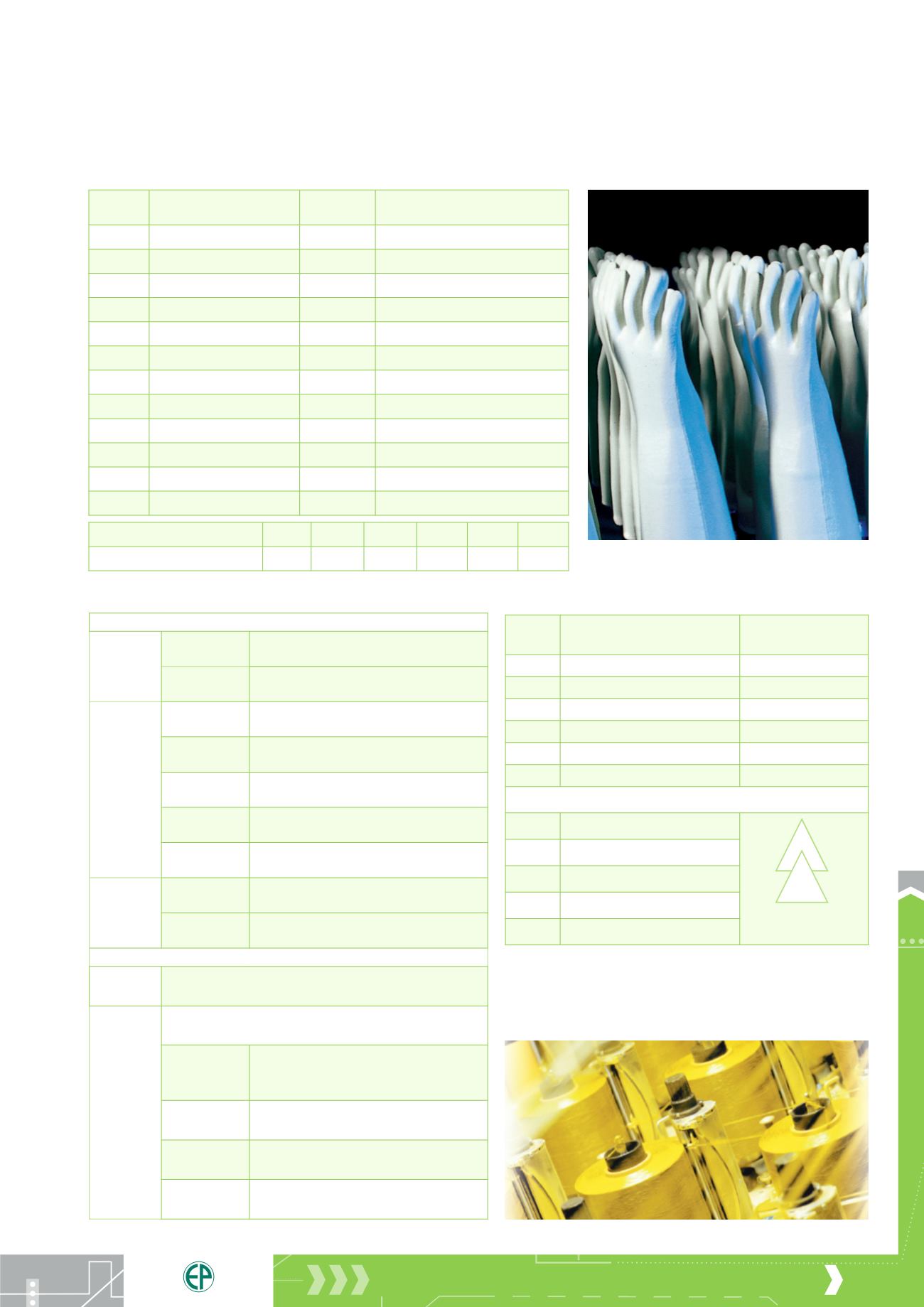
127
EURO PROTECTION • PROTECTIVE GLOVES
EN374-2 Protection against microorganisms
For the assessment of penetration, water leak test/air leak test is performed to verify that the material of the protective gloves acts as a
barrier tomicroorganisms. As aminimum, level 2 defined in ISO2859must also be compliedwith (AcceptableQuality Level, AQL: 1,5).
EN374-3 Protection against chemicals
Test performed in order to assess penetration resistance to chemicals verifies that a minimum of 3 chemicals selected from
the table do not break through and diffuse into the material of the protective gloves at molecular level for a minimum of 30
minutes (chemicals are denoted by the letters below the flask sign).
Marking
Chemical
Chemical
formula
Rating
A
Methanol
C
10
H
20
O
Alcohol
B
Acetone
C
3
H
6
O
Ketone
C
Acetonitrile
C
2
H
3
N
Nitrile
D Dichloromethane CH
2
Cl
2
Chlorinated paraffin
E
Carbon disulfide
CS
2
Sulphur + organic compound
F
Toluol
C
7
H
8
Aromatic hydrocarbon
G
Diethylamine
C
4
H
11
N
Amine
H Tetrahydrofuran
C
4
H
8
O
Heterocyclic ether
I
Ethyl acetate
C
4
H
8
O
2
Ester
J
n-Heptane
C
7
H
16
Saturated hydrocarbon
K Sodium hydroxide 40% NaOH
Inorganic base
L
Sulphuric acid 96% H
2
SO
4
Inorganic base
Breakthrough time (min)
> 10 > 30 > 60 > 120 > 240 > 480
Protection level (class)
1.
2.
3.
4.
5.
6.
Types of textile gloves
EN60903 protection against electrical voltage
Textile gloves as per base material
Natural
cotton skin-friendly (for underglove or for the
protection of the workpiece)
other
other natural fibers(e.g. bamboo)
Synthetic
fiber
polyamide elastic, wear resistant, high tensile
strength
polyester
good tensile strength and insulation
polypropylene high wear resistance and hydrophobic
(water repellent)
aramids flame and heat-resistant material, cut
resistant (e.g. Kevlar, Nomex)
other
other synthetic fibers, combinations
(e.g. Dyneema, Spectra, Taeki)
Combined
fiber
different
fibers
plating: cotton on the inside, synthetic
fibers on the outside
elastane elastic, close-fitting components (e.g.
Lycra, Spandex)
Textile gloves as per method of manufacture
Sewn
gloves sewn from finished fabric, more homogeneous
surface, loose fit
Knitted
weft-knitted gloves without inner seams, fineness as per the
number of needles across the width of one inch (25,4 cm):
coarse
(> 7)
gloves with good breathability and
resistance properties made of thicker
threads
intermediate
(> 10)
gloves of intermediate thickness
providing good dexterity
fine
(> 13)
precision, close-fitting gloves from fine
threads
looped loops made by sandwich plush knitting
mostly on a synthetic thread base
Rating
Test voltage
Operating voltage
00
2,500 V
500 V
0
5,000 V
1,000 V
1
10,000 V
7,500 V
2
20,000 V
17,500 V
3
30,000 V
26,500 V
4
40,000 V
36,000 V
Supplementary classes of protection
A
against acids
H
against oils
Z
against ozone
R against acid, oil and ozone
C protection up to -40 °C
Insulating protective gloves with an insulation rating of 1-4
must be subjected to periodic unit testing every six months,
protective gloves with an insulation rating of 00 and 0 must be
subjected to air leak test and visual inspection, as a minimum.


